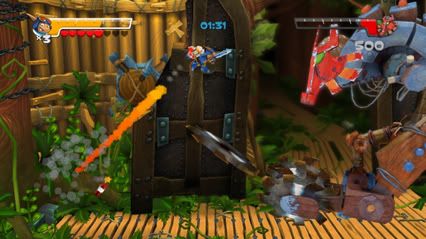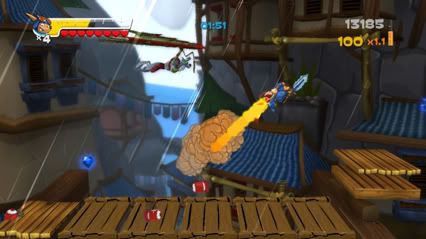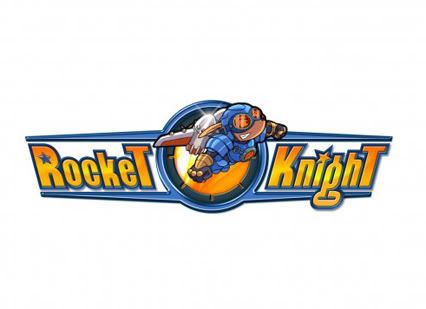- Format: XBLA (version reviewed), PSN, PC
- Unleashed: Out Now
- Publisher: Konami
- Developer: Climax Studios
- Players: 1
- Site: http://konami.com/games/rocket-knight/
Lost in the shuffle of mid-nineties mascot overload, the original Rocket Knight Adventures is an oft-forgotten Sega Genesis/Megadrive masterpiece. The sheer variety from one area to the next is still impressive today – there are only a few levels where the game plays like a standard 2D platformer. When Sparkster, the game’s opossum hero, isn’t zipping through the air in Gradius-inspired shooter stages, riding a mine-cart, or playing rock ‘em sock ‘em robots, he hangs by his prehensile tail or bounces off the walls with his jet-pack. The game never rests on its laurels, and yet the moment-to-moment gameplay remains simple and intuitive.
Which begs the question – what the heck happened with Rocket Knight, the modern-day downloadable sequel? Aside from the iconic protagonist and bouncy rocket attack, the game is almost unrecognisable from its predecessor.
The original was great because it never relied entirely on its gimmick – it was an adventure where you just happened to be armed with a rocket pack. Rocket Knight, on the other other hand, feels extremely designed – you’re not traversing a world so much as you’re solving a bunch of similar puzzles. Ultimately, you get a lot more use out of the rocket pack than you ever did in the original game, but all that does is reveal how sloppy the thing controls in difficult situations.
 A handful of small but fundamental changes make for a game that feels frustrating rather than challenging, and a hero that feels unwieldy rather than empowered. For one, the beam that shot out of Sparkster’s sword is essentially gone (delegated to a separate button, not to mention weak and useless), forcing you to get in close to attack enemies. This is an odd move, completely changing the feel of the game from a Megaman or Contra-style shooter, to a more close-quarters game like Castlevania. That’d be fine, except the enemies also have some rather infuriating collision boxes – it means you have to get close, but you also can’t touch the enemies or you’ll take damage.
A handful of small but fundamental changes make for a game that feels frustrating rather than challenging, and a hero that feels unwieldy rather than empowered. For one, the beam that shot out of Sparkster’s sword is essentially gone (delegated to a separate button, not to mention weak and useless), forcing you to get in close to attack enemies. This is an odd move, completely changing the feel of the game from a Megaman or Contra-style shooter, to a more close-quarters game like Castlevania. That’d be fine, except the enemies also have some rather infuriating collision boxes – it means you have to get close, but you also can’t touch the enemies or you’ll take damage.
What Rocket Knight Adventures accomplished with two buttons, the new Rocket Knight curiously spreads across an entire modern controller. Sparkster’s rocket dash and spin attack are placed on separate buttons, allowing the player to invoke them at any time, rather than charging them up in advance. Maybe it’s just that these moves don’t work as well as they did in the first game, but the result is that they suddenly feel trivial. You don’t need to plan in advance to use them, meaning you don’t really have to think. It strips out a lot of the creativity that came with how you approached situations in the original.
 The worst offence of the game isn’t how it messes with the formula, it’s how it waters it down. Aside from a few flying stages, the game plays as a straight platformer. Rocket Knight is twice as long, and half as interesting and unique as the game that inspires it.
The worst offence of the game isn’t how it messes with the formula, it’s how it waters it down. Aside from a few flying stages, the game plays as a straight platformer. Rocket Knight is twice as long, and half as interesting and unique as the game that inspires it.
On its own terms, Rocket Knight is just kind of boring – but as a sequel to a beloved game, it’s an unfaithful step backwards. It’s a solid platformer, but it makes few attempts to stand out or capture the nostalgia of the original.
2/5

















I DL’d this game on Friday, and aside from it being overpriced, I thought it was one of the best games I’ve played this year. And that’s saying A LOT.
Secondly, it probably doesn’t matter much, but I played it from Steam. Loved it. Couldn’t imagine not using a gamepad, however. The keyboard would be too difficult.